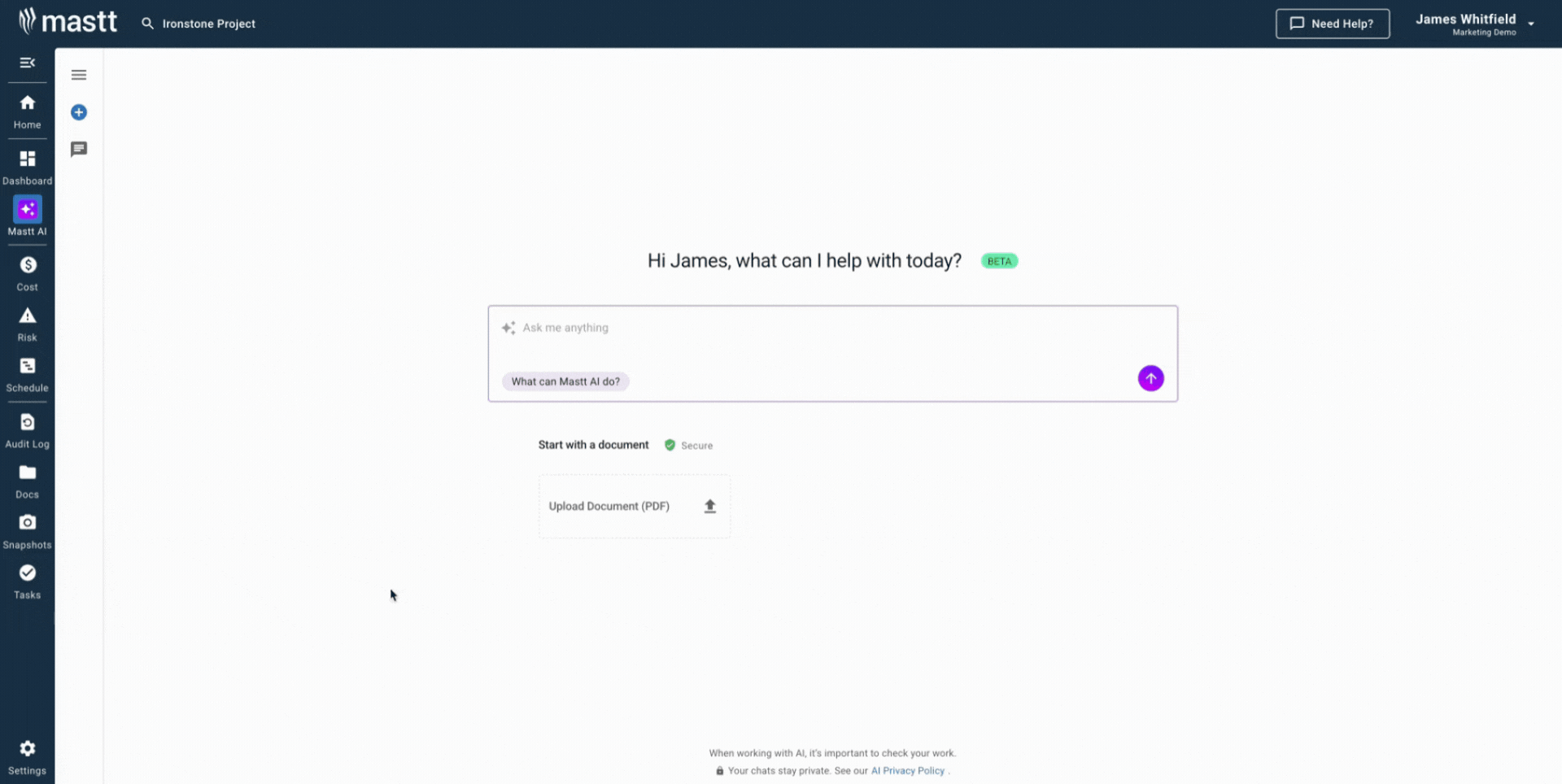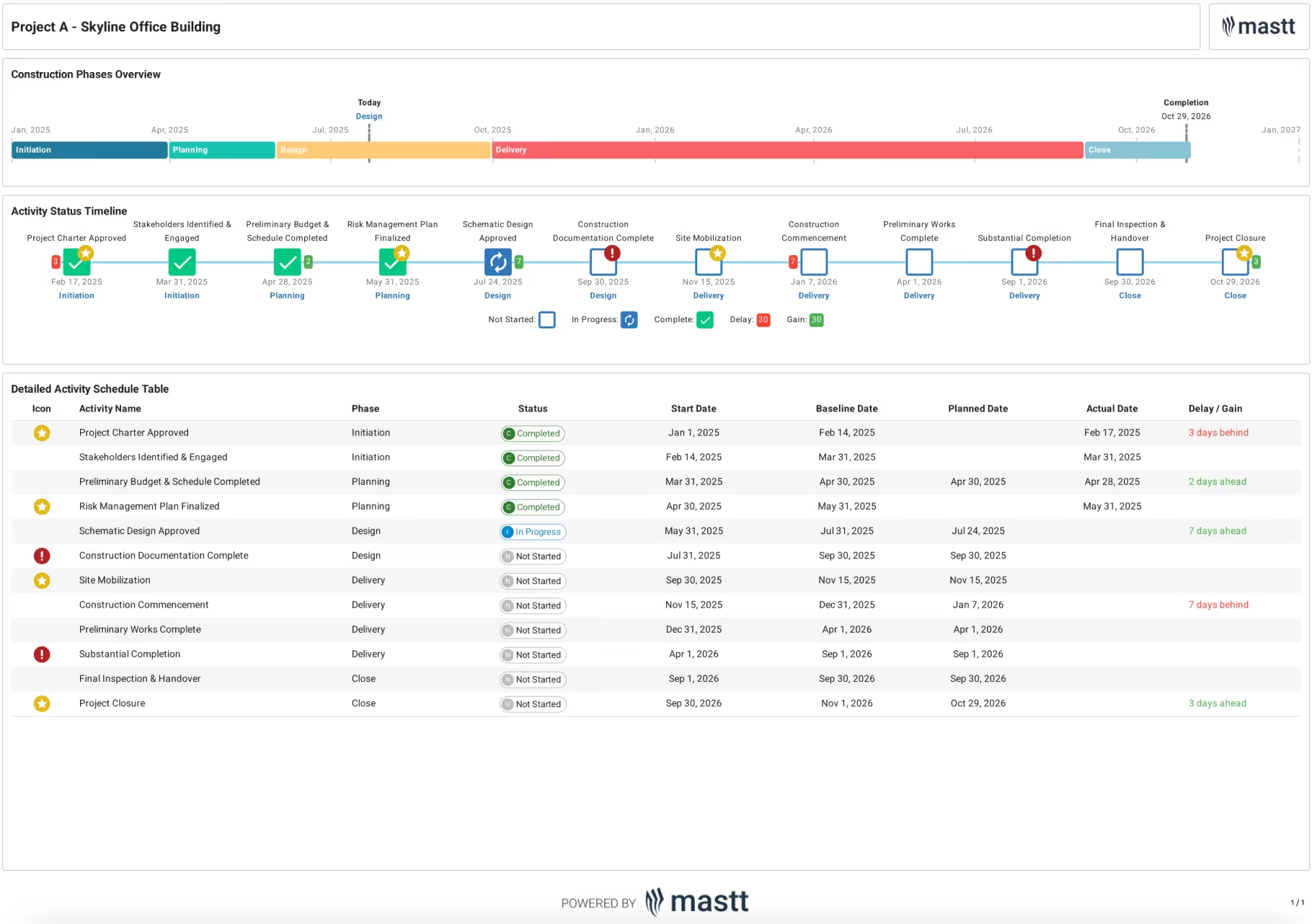What is a Stage Gate Process Template?
A stage gate process template is a structured document that maps out project phases and the approval criteria required at each decision gate. The template provides pre-formatted sections for documenting deliverables, evaluation scorecards, and approval decisions throughout the project life cycle.
In construction project management, teams use this template to standardize how gate reviews are conducted. Each template defines what information project managers must prepare, what criteria gatekeepers evaluate, and how decisions get documented at every checkpoint.
What's Included in Stage Gate Process Templates?
A typical template for stage gate process contains structured sections that guide projects from initial concept through final delivery. The template organizes all critical information gatekeepers need to make informed go/kill decisions.
Essential components found in stage gate process templates include:
- Stage definition section: Names and descriptions for each project phase, typically feasibility, concept development, detailed design, execution, and closeout.
- Gate criteria tables: Pre-formatted checklists with must-meet knockout questions and should-meet scorecard ratings for technical, financial, and strategic factors.
- Deliverables checklist: Required outputs listed for each stage, such as business cases, cost estimates, risk assessments, and schedule baselines.
- Decision matrix: Structured options (Go, Kill, Hold, Recycle) with fields for documenting rationale and conditions for advancement.
- Approval workflow diagram: Visual representation showing who reviews what at each gate and the sign-off sequence, often presented as a stage gate process flow chart.
- Scorecard templates: Rating scales with weighting factors that quantify project attractiveness against priorities.
- Meeting agenda format: Standard structure for gate review meetings including timing, participants, discussion topics, and decision protocols.
- Action item tracker: Fields for recording next steps, responsible parties, and deadlines when projects advance to the next stage.
💡 Pro Tip: Lock your gate criteria at the start of each stage and require formal change control to modify them. Most failed gate processes die from criteria that shift based on who's in the room or what answer management wants to hear.
Why Use a Template for Stage Gate Management?
Using a template for stage gate management eliminates inconsistency in how projects get evaluated. Templates ensure every project faces the same rigor rather than ad-hoc approval processes, protecting investments through standardized decision-making.
Key advantages of using stage gate process templates include:
- Standardized evaluation: Pre-defined criteria in the template mean projects get judged by identical standards, removing bias from investment decisions.
- Time savings: Templates eliminate starting from scratch for each gate review, reducing preparation time by 50-70% compared to custom documents.
- Complete documentation: The template's structured format ensures no critical evaluation factor gets overlooked during reviews.
- Clear expectations: Project teams see exactly what deliverables and criteria they must satisfy in the template before reaching each gate.
- Faster approvals: Stakeholders familiar with the template format can review projects more efficiently because information appears in predictable locations.
- Audit compliance: Completed templates create permanent records of decisions that satisfy governance and regulatory requirements.
- Professional credibility: Consultants deliver structured templates that demonstrate expertise and add value for clients.
Templates transform gate reviews from subjective discussions into objective evaluations. The structured format prevents good projects from being rejected for wrong reasons and stops poor projects from consuming resources.
How to Use a Project Stage Gate Template
One of the best practices for using a project stage gate template is customizing it to your specific project phases before deployment. Populate each section progressively as the project advances through stages, updating deliverables and criteria before gate reviews.
- Customize stage definitions: Modify the template's phase names to match your project types, whether FEL (Front End Loading) 1-3 or custom stages.
- Define gate criteria: Fill in the must-meet checklist and should-meet scorecard sections with specific evaluation factors relevant to your project.
- List required deliverables: Populate the template's deliverable fields with exact outputs needed, such as cost plans, risk registers, or design drawings.
- Assign decision makers: Enter names in the approval workflow section identifying who evaluates and approves at each gate level.
- Track stage completion: Update the template's status fields as teams complete deliverables and prepare for upcoming gate reviews.
- Conduct gate evaluations: During reviews, complete scorecard ratings and checklist responses directly in the template while discussions occur.
- Record outcomes: Document the decision (Go, Kill, Hold, Recycle) in the matrix with clear reasoning and any advancement conditions.
- Archive for audit: Save finalized templates as project records that show the complete approval history and decision rationale.
💡 Pro Tip: Reference the template weekly during project status meetings, not just at gate reviews. Teams that update the template continuously arrive at gates 90% prepared, while those who ignore it until review week scramble to manufacture evidence they met criteria.
Get the Best-Fit Stage Gate Process Template with Mastt AI
Creating comprehensive stage gate process templates manually takes hours of formatting tables, checklists, and approval workflows. Mastt's AI Template Studio generates complete templates instantly, tailored to your specific project phases and evaluation criteria.
With AI Template Studio, you immediately access:
🚀 Explore ready-made templates: Access dashboards built for project governance and gate tracking.
🎯 Get AI recommendations: Describe what you need in plain language, and AI instantly suggests three template options that match your requirements.
⚡ Start with a complete template: Launch dashboards that organize project data, track progress, and support decision-making across stages.
📊 Skip manual formatting: Templates come structured and ready to populate with your project information, criteria, and approval workflows.
Instead of building stage gate process templates from scratch in Excel or PowerPoint, you'll have a professional template ready in minutes.
Here's how to create your template with AI Template Studio:
- Open AI Template Studio: From your Mastt dashboard, click Start a Dashboard in the top left corner and select AI Assisted.
- Describe your needs: In the search box, type your request like "stage gate process template" or "project governance dashboard with approval criteria."
- Review AI recommendations: AI presents three template options. Click Preview on any option to see the full structure and read descriptions.
- Refine if needed: If the recommendations don't fit perfectly, enter a new query to get different template options.
- Select and launch: Once you find the right template, click Use This Template and Mastt builds it instantly.
Find complete guidance on using AI Template Studio in our Help Center.

Who Should Use Stage Gate Process Templates?
A stage gate process template is used by professionals who prepare, review, or approve projects at decision gates. These templates serve both individual contributors preparing documentation and decision makers evaluating project readiness.
✅ Project Owners and Developers managing capital investments and staged funding decisions.
✅ Owner's Representatives overseeing project governance on behalf of clients.
✅ Project Management Consultants establishing governance frameworks for client organizations.
✅ Client-Side Project Managers preparing gate review materials and coordinating approvals.
✅ overseeing multi-phase programs with multiple decision gates.
✅ Portfolio Managers and PMO (Project Management Office) Directors evaluating projects across organizational portfolios.
✅ Steering Committee Members reviewing projects and making go/kill decisions at gates.
✅ Project Controls Managers tracking performance data against gate criteria and baselines.
💡 Pro Tip: If you're a consultant establishing governance for a client, run their first 2-3 gate reviews yourself using the template. Once stakeholders see how it works in practice, adoption becomes effortless.
When to Use Project Stage Gate Templates?
Project stage gate templates should be deployed at the beginning of projects and maintained throughout the delivery lifecycle. Use them from initiation through closeout whenever structured decision-making is required at key milestones.
Apply stage gate templates in these situations:
- Project initiation: Deploy at project kickoff to define gates from the start.
- Client governance setup: Introduce when establishing formal approval processes for new clients.
- Funding approval requirements: Apply when staged funding releases are tied to gate clearances.
- Portfolio standardization: Implement across multiple projects simultaneously for consistency.
- Executive reporting cycles: Use when regular reporting to leadership is required.
- Compliance mandates: Deploy when regulatory or organizational policies require formal documentation.
- High-value projects: Apply on capital projects where staged decisions reduce investment risk.
💡 Pro Tip: Don't wait until your first formal gate review to introduce the framework. Distribute it at project kickoff so teams track deliverables weekly and arrive at gates fully prepared instead of scrambling last-minute.
Common Problems with Stage Gate Process Template in Excel and PowerPoint
Manual templates in spreadsheet or presentation formats create gaps that compromise effectiveness. Even well-designed stage gate process template Excel files struggle under real project conditions.
Issues teams encounter with manual stage gate process templates include:
⚠️ Lost template versions: Multiple people editing files create dozens of conflicting versions with different criteria or outdated decisions.
⚠️ Broken formulas: Scorecard calculations in stage gate process template Excel files break when users accidentally delete cells or change formatting.
⚠️ Manual updates required: Static templates need constant manual updates to reflect current project status, and teams inevitably fall behind during busy periods.
⚠️ No real-time collaboration: Only one person can edit spreadsheet or PowerPoint files at a time, creating bottlenecks when multiple stakeholders need access.
⚠️ Difficult project tracking: Consultants managing templates for multiple clients require separate files for each project, making updates tedious and error-prone.
⚠️ Poor audit trails: Templates don't automatically record who made changes, when decisions occurred, or why criteria were modified.
⚠️ Inconsistent formatting: Team members customize templates differently, making reviews confusing when every project looks different.
⚠️ Limited scalability: Managing stage gate process template Excel and PowerPoint files across multiple projects becomes impossible when everything exists as separate documents.
⚠️ Outdated flow charts: Visual diagrams embedded in static files quickly become obsolete when stages change or approval workflows evolve.
Transform Stage Gate Governance with Mastt
Effective gate reviews require more than static templates. Mastt transforms traditional stage gate process template Excel and PowerPoint approaches into intelligent dashboards that connect to live project data and update automatically.
With Mastt's AI Template Studio, you build comprehensive stage gate process templates in minutes. Every template maintains consistency across all projects while creating complete audit trails without manual documentation.
👉 Create better stage gate process templates with Mastt's AI Template Studio today and structure your project reviews with confidence.










